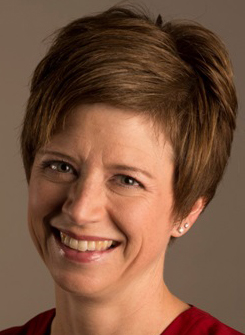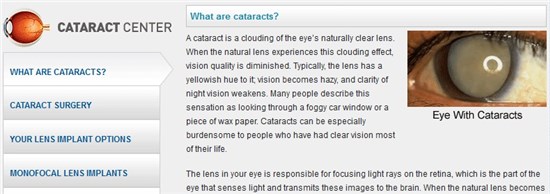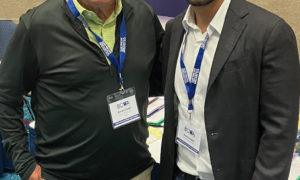By Tina McCarty, OD, FAAO

January 28, 2015
If you live long enough, chances are you will develop cataracts. With our aging population, there are ample opportunities to co-manage cataract patients with local eye surgeons and make that a winning practice builder. On average, our practice co-manages 300 cataract surgeries annually. Making the most of this opportunity requires letting patients know the full range of services you offer, nurturing relationships with surgeons, and establishing systems for your office to process claims efficiently.

Educational information about cataracts presented on Dr. McCarty’s practice web site. Dr. McCarty says it is important to walk the patient through the pre- and post-operative process, including letting them know what to expect and assuaging fears.
Cataract Co-Management Builds Profitability
There is profit to be gained from regular co-management fees, but the more complicated or more time intensive co-management cases such as combined cataract surgery with some type of glaucoma surgery (such as trabeculectomy or iStent) or a premium IOL (such as a toric or a multiocal) can generate higher co-management fees. Most post-op cataract patients will need new eyewear and they have a heightened need for sunwear to aid in protecting from UV exposure after the cataract has been removed. Both needs generate revenue in our optical, however, the real money gained though these patients is the dividends paid year after year by their loyalty. Satisfied cataract patients can be a great source of referrals.
Opportunity to Emphasize Medical Eyecare Services
If patents know that we are able to manage pre- and post-op cataract services, then they automatically know that we can handle other medical needs, as well. We want to be that first call for dry eye, red eye, new floaters and other eye health concerns. It can be hard to globally market specific medical eyecare, but it is pretty easy for a patient to understand that we are medical eyecare providers if we are co-managing surgery.
Establish Relationships with Local Surgeons
I was fortunate to complete a great residency in anterior segment disease, as well as cataract and refractive surgery, in the same city that I ultimately established practice in. The same surgeons who trained me are the ones who I am now co-managing with. I appreciate the relationships as we trust each other and know each others’ skills and capabilities. When my patients are in the surgery center, these surgeons are reinforcing my skills and expertise to the patient so they are even more confident returning to me. Our practice makes a point of having face-to-face meetings with our co-managing surgeons at least a couple of times a year to foster our working relationship.
Create Smooth Billing Procedure
One simple but big key is making sure all bills are submitted accurately and timely with the appropriate codes and modifiers that mirror how the surgeon billed the procedure and the days of service being managed (be it immediately for the whole 90 days or some fraction thereof). Your billing department should keep track of the patients returning for post-op and should make sure you have the appropriate transfer-of-care documents in your medical record from the surgeon’s office before billing for your services.
Educate Patients Prior to Surgery
We do our best to educate patients during every visit leading up to cataract surgery decision time. A patient needs to be appropriately educated on all the risks, benefits and alternatives of cataract surgery. The process starts with telling patients they have an early cataract, and what to do to slow the progression and what signs or symptoms they may experience as the cataract develops. By the time surgery becomes necessary, patients understand we will help to manage the process though to completion. We have cataract pamphlets in the office, information on our web site and we use a patient education software that allows us to e-mail videos about the process to the patient to be viewed again at home. We also host cataract patient information seminars in our office, as well as regularly participate in local senior expos to help educate not only our patients, but prospective new ones.
Address Fears of Patients
I assure patients that I have helped many patients–including close family members–through the process of cataract surgery with success. I let the frightened patient know that other patients often tell me they wished they would have had the surgery sooner, or were surprised at how quick and easy it was. If they don’t already know, I also tell them that cataract surgery is among the most common procedures in our country, and that the rate of success is very high. We also talk about the possibility of minimizing dependence on glasses/contact lenses after the procedure, which is always an added bonus.
Set Realistic Expectations About Multifocal IOLs
Setting realistic expectations for multifocal IOLs isn’t much different than setting realistic expectations for multifocal contact lenses. I check for motivation and expectations first. If either are out of line, the patient is not a candidate as it is difficult to be successful in multifocal IOLs if the motivation is questionable or expectations unrealistic. I educate every patient on all the options available, determine what their specific needs are and offer recommendations that will meet their needs. The patient then sees the surgeon–who has been briefed on my conversation with the patient–for a pre-operative consultation. After having time to think about it, the patient may have new questions or maybe is just reinforced in their decision.
Educate On Need to Return to Practice for Regular Checkups
Our patients have been well trained in the years leading up to the surgery to know that an annual comprehensive eye exam is necessary to evaluate the health and refractive status of the eye. A cataract or cataract surgery is just one small part of our assessment. At each exam we talk about monitoring for disease such as dry eye, glaucoma and macular degeneration, as well as working with the patient to make sure they are seeing their best with the appropriate eyewear to meet their needs and visual demands.
Tina McCarty, OD, FAAO, is a partner of Eye Care Center in Fridley, Maplewood and Maple Grove, Minn. To contact her: tina.mccarty@eyecarecenters.net



























